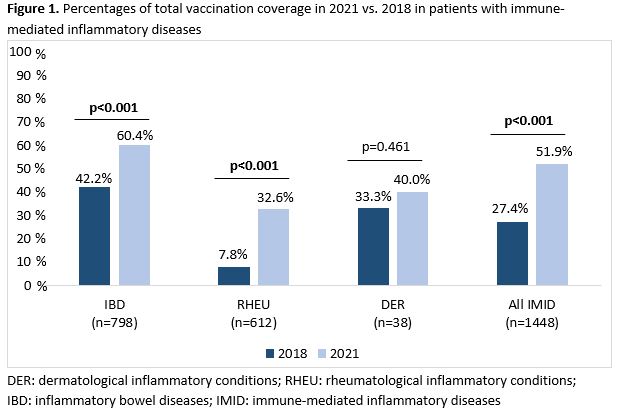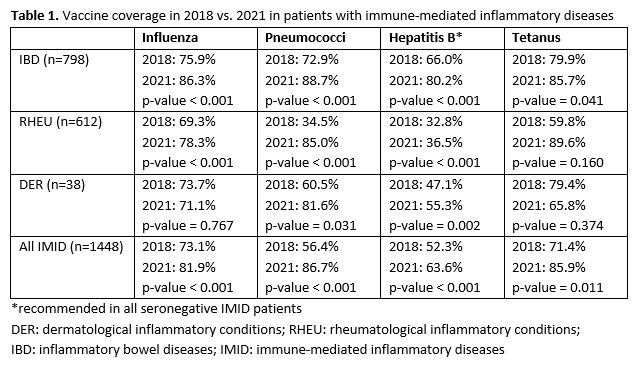P115 Implementation of a vaccination tool in the electronic patient health record significantly increases vaccination coverage
Fierens, L.(1);De Dycker, E.(2);Joly, J.(3);Vanhoutvin, T.(4);Verschueren, P.(3,5);De Haes, P.(4,6);Sabino, J.(1,2);Vermeire, S.(1,2);Ferrante, M.(1,2);
(1)KU Leuven, Department of Chronic Diseases and Metabolism, Leuven, Belgium;(2)UZ Leuven, Department of Gastroenterology and Hepatology, Leuven, Belgium;(3)UZ Leuven, Department of Rheumatology, Leuven, Belgium;(4)UZ Leuven, Department of Dermatology, Leuven, Belgium;(5)KU Leuven, Department of Development and Regeneration, Leuven, Belgium;(6)KU Leuven, Department of Microbiology- Immunology and Transplantation, Leuven, Belgium;
Background
Patients with immune-mediated inflammatory diseases (IMID) are at higher risk for infectious diseases. Despite this increased risk and the available guidelines1, we reported a sub-optimal vaccination rate of 27.4% of IMID patients in 2018. In the meantime, a vaccination module was introduced in the electronic patient health record of our hospital to accurately document and monitor vaccination status of patients. The impact of this new module on vaccination coverage was re-evaluated in the same IMID patients in 2021.
Methods
Between Aug and Oct 2021, the vaccination status of 1448 (out of the original 1488) IMID patients (44.8% male, median age 53.6 years) was collected (798 patients with IBD, 612 with rheumatological, and 38 with dermatological inflammatory conditions) and compared to that of 2018. The vaccination status was obtained mainly through the patients’ electronic medical records. Missing data were added after contacting patients or their general practitioner.
Results
From 2018 to 2021, the overall vaccination coverage of all IMID patients significantly increased from 27.4% to 51.9% (p<0.001, Figure 1).
The vaccination coverage in IBD patients increased significantly from 75.9% to 86.3% for influenza (p<0.001), from 72.9% to 88.7% for pneumococci (p<0.001), from 66.0% to 80.2% for hepatitis B (p<0.001), from 79.9% to 85.7% for tetanus (p=0.041) and from 42.2% to 60.4% overall (p<0.001) (Figure 1 and Table 1).
Similarly, the vaccination coverage significantly increased for rheumatology patients, namely from 69.3% to 78.3% for influenza (p<0.001), from 34.5% to 85.0% for pneumococci (p<0.001), from 32.8% to 36.5% for hepatitis B (p<0.001) and from 7.8% to 32.6% overall (p<0.001) (Figure 1 and Table 1).
For patients with dermatological inflammatory conditions, vaccination coverage significantly increased from 60.5% to 81.6% for pneumococci (p=0.031) and from 47.1% to 55.3% for hepatitis B (p=0.002) (Table 1).
Conclusion
The suboptimal vaccination rate measured in 2018 and the COVID-19 pandemic stressed the importance of vaccination recommendations to patients and healthcare professionals. We here show that the implementation of a vaccination tool integrated in the electronic medical record of patients is correlated with a significant increase in specific vaccination rates and also in the total amount of IMID patients that were fully vaccinated according to guidelines.
1. Rahier JF, Magro F, Abreu C, et al. Second European evidence-based consensus on the prevention, diagnosis and management of opportunistic infections in inflammatory bowel disease. J Crohns Colitis. 2014;8:443–468.




